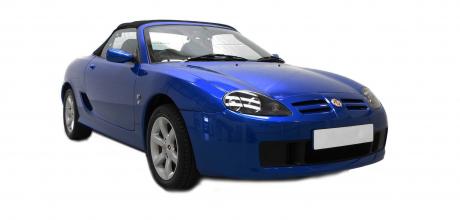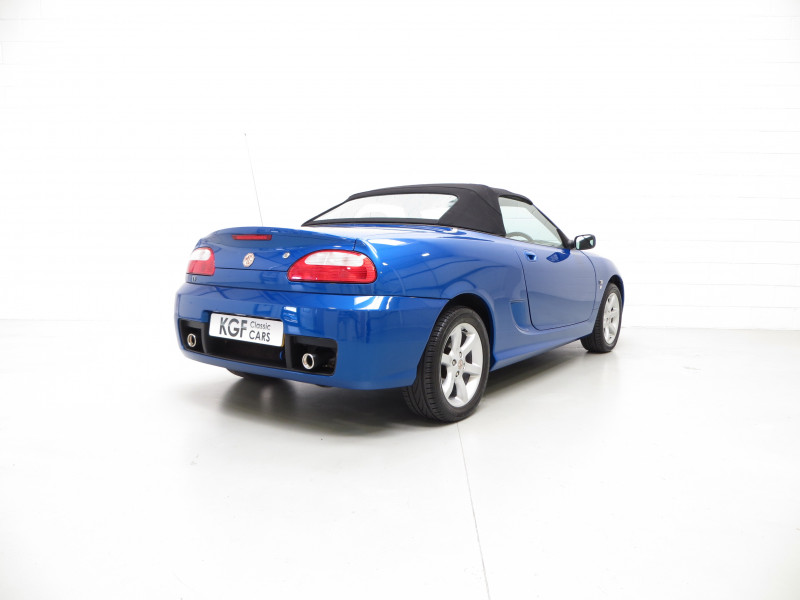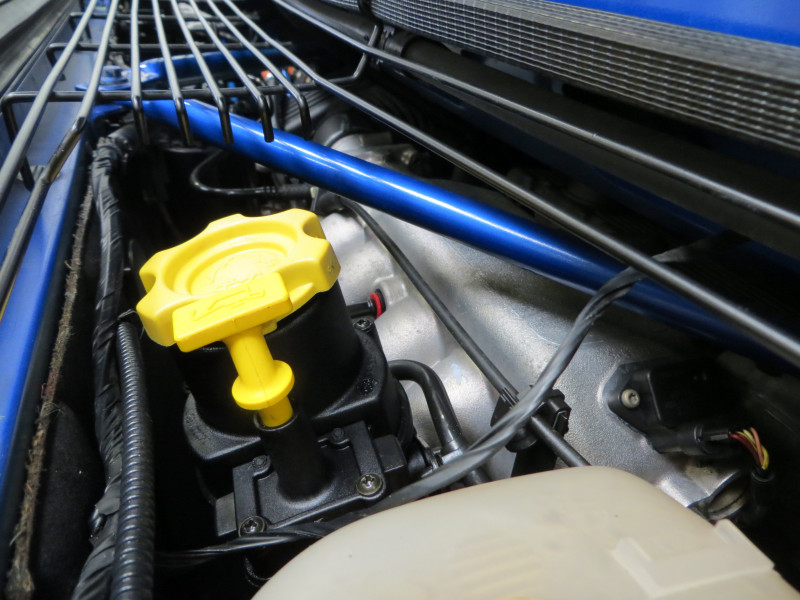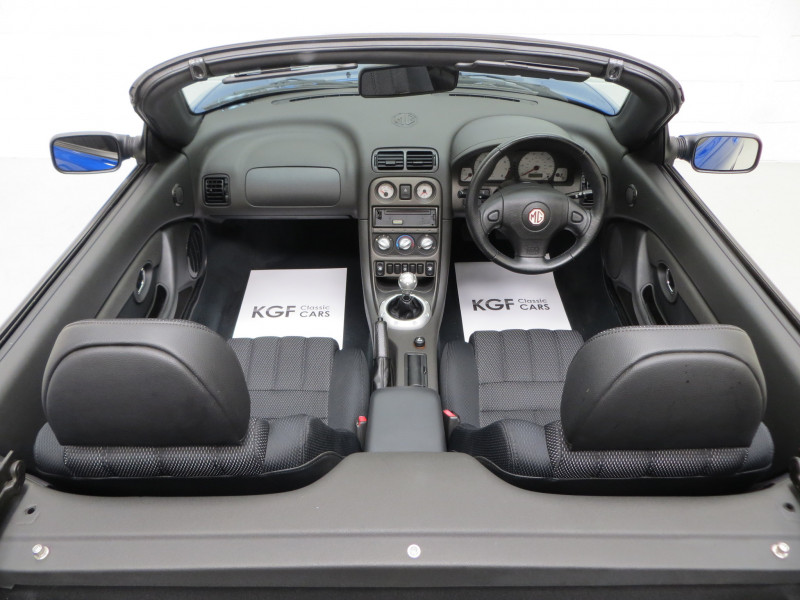Buyers Guide MG TF

Without the worry of Hydragas parts supply, the steel-sprung TF has gained a new following. Here’s what you need to know about the last proper MG.
Words Paul Wager
SECOND CHANCE
BUYING GUIDE: MG TFSo similar and yet so very different from the original F, the TF is an intriguing prospect.
The MG TF. It’s just an MGF without the Hydragas, right? Wrong. Very wrong in fact. The TF – its name reviving a badg first used in the 1950s – may have looked very similar to its predecessor but it was in reality significantly different under the skin. Sure, the rear-engined configuration and indeed the K-Series powerplant and Metro-derived running gear remained, but in order to accommodate conventional steel coil springs, the bodyshell required substantial re-engineering.

Why the change to coil springs? Well you can blame the famously poor showing of the Rover Metro (in Rover 100 guise) in the 1997 NCAP crash tests for that, since its one-star performance pretty much killed it stone-dead in the market, production ending in 1998. Since the Metro was by then the only volume-produced car using the Hydragas system, Dunlop called time on production of the displacer spheres. The cost of producing them could no longer be justified for the tiny volumes represented by the MGF alone, which forced MG Rover’s hand in adopting a solution.
Developing a replacement car from the ground up would have been prohibitively costly for MG, by then without the might of BMW behind it, but there was just enough in the kitty to redesign the car around conventional suspension. The opportunity was taken to do more than simply revamp the suspension though, the time being taken to give the car a mid-life facelift with a more aggressive appearance courtesy of that master of the budget makeover, Peter Stevens.
As a happy by-product of the bodyshell revisions, the shell became some 20 per cent stiffer and achieved a commendable four-star NCAP result – the only open car in its class to do so. The end result was a car which was more focused than the easy-riding MGF and more akin to something like the Elise in its feel. The new car was further distanced from the saloon-car feel of the MGF which had won it so many converts, by the simple expedient of lowering the seat cushions to create a lower, more traditional sports car-like driving position. The result was a car which was at once so similar yet very different from the MGF, yet no less fun to drive.
Today, values of the TF have followed the MGF and the cars are currently very affordable. As time passes, the TF is also becoming the smart choice for MGF enthusiasts worrying about the future availability of Hydragas parts and although the Hydragas spheres can now be refilled and there are coil conversion kits available for the F, the TF was of course designed that way from the start. Here’s what you want to know if you’re in the market for a midengined future-proof MG.
HISTORY
The TF was launched in 2002 with the K-Series uprated with revised manifolding and producing 135 bhp in its basic form, with the 115 bhp and 160 bhp options remaining, but the 160 bhp now doing without the VVC.
In 2005 criticisms of the overly harsh ride were answered with the introduction of a ‘comfort’ offering using slightly softer settings, while the roof was given a glass rear window.
These two changes made a real difference to the user-friendliness of the car, but of course MG Rover crashed into oblivion shortly afterwards with production ending in April after 39,249 TFs had left Longbridge. Incredibly, the car refused to die. Following the firm’s acquisition by the Chinese, production was restarted in China from 2007, with cars being assembled in Longbridge from CKD kits from 2008 and featuring revisions to front end, engines and interior. First to come was the limited-edition LE500, followed by the TF135, essentially using a modified version of the previous 135bhp K-Series engine. An 85th anniversary model was produced in 2009 with production finally ending in 2010.
BODY
Perhaps surprisingly for a car tainted by association with the BL stigma, the TF doesn’t rust unduly and certainly body rot is nothing like the issue it is with for example the Mk1/Mk2 Mazda MX-5. Like the MGF, it’s not unusual to find bubbling paint on the offside front wing in a small area behind the headlight, while the underside of the sills can also get scabby on higher-mileage cars.
One thing which is specific to the TF is the soft metal used in the bushings for the door hinge pins. Over time, this simply wears away, the effect being that the door then drops and in extreme cases it will catch on the sill, damaging the paint and causing rust. Better-quality replacement bushings are cheap and with an assistant to take the weight of the door, it’s a simple DIY job to replace them.
The good news is that all panels are available through suppliers like Rimmers which acquired a lot of the ex-factory parts. In fact the firm even has a stock of complete TF bodyshells plucked from the Longbridge assembly line.
ROOF
As with any convertible, check the fabric for damage and holes. Take a close look at the plastic rear window too, since it suffers badly if owners don’t help it to fold neatly when lowering the roof. If the hood is simply tired-looking then a good renovating kit will work wonders and we’ve had good experience with the Furniture Clinic kits which can be used to recolour and waterproof the fabric. If the hood is too far gone for this, then it’s a DIY prospect to replace the fabric on your existing frame and the later 2005-on design with the glass heated window retails for £250, making for a nice upgrade.
Speaking of the frame, if the roof doesn’t want to fold easily then check the condition of the elastic webbing straps connecting the transverse bars above the driver’s head – when they weaken, the intermediate bar doesn’t raise itself. Simply move it by hand and the roof will lower easily.
ENGINE
Ah yes, the K-Series. We’ll have to mention head gaskets… except that in reality the TF suffered far less than the F. It’s also fair to say that most cars still running now will have received a replacement gasket, either when the original failed or because a caring owner wanted to avoid exactly that. Most specialists are agreed that the revised head gasket design fitted nowadays solves the problem. That is, as long as the cooling system is kept up to scratch and on both F and TF that does require more attention than many other cars.

The main issue is that there are so many places for the system to leak, with the two rigid coolant pipes running between the radiator at the front and the engine in the back, plus the four rubber pipes connecting them at either end.
The radiator is also hidden from view in the front boot by the bodywork shrouding and only really visible from below with the car on a ramp, which is why a failing radiator often goes undetected for so long.
The smart thing to do with any recently acquired TF is to replace the mild steel underfloor coolant pipes with the popular stainless replacements and to throw in a radiator and set of coolant hoses for good measure. The parts are cheap and with this done the car will be good for another 10 years. Many owners will also fit a low coolant warning system, something which was only fitted to the 2004-on cars.
It goes without saying that if the header tank and engine bay area shows signs of boiling over then beware.
The cam belt should also be changed every four years or 60,000 miles, so evidence of a swap is good news. A screeching alternator belt isn’t uncommon as the adjuster bolt tends to seize, meaning the belt doesn’t get tensioned correctly. It’s a simple matte to free it off or simply replace the offending bolt.
Don’t be concerned by an oil temperature gauge which doesn’t seem to move much – they all do that. After a long motorway blast it should start to rise a little. As for the temperature gauge, it seems to sit just slightly above the middle on many cars, suggesting it was simply badly calibrated… not the best idea on a car with a reputation for cooling issues. It’s also possible to achieve great results by remapping the TF engines and Kmaps (www.kmaps.co.uk) are acknowledged masters of this, staffed by ex-MG development engineers who can provide a factory-developed performance map. We’ve run a 135 TF with their remap and it was a blast to drive, so if an owner tells you they’ve had this done then look on it as a bonus rather than a drawback.
SPECIFICATIONS
BRAKES
It’s a conventional set-up and problems will be limited mainly to sticking calipers, especially on cars which have been standing. These are lightweight cars, so the standard setup with decent pads is well up to the performance.
TRANSMISSION
There’s not much to worry about here with the PG1 manual box being a Honda-derived unit. The gearlever itself is more saloon car-like in its length but changes should be light and positive. If the gears are tricky to find, then suspect the shift cables which can be adjusted or simply replaced. The bolts around the shift lever housing can also work loose.
The automatic in the Step-speed model is in fact a CVT transmission so don’t assume it’s slipping if it sounds unusual on a test drive as that’s the nature of a CVT.
SUSPENSION
On the TF, there’s little to worry about, with issues being mainly limited to consumables like wheel bearings. If the ride is just too harsh – and to be honest it is pretty uncompromising – then Rimmers can supply the factory comfort-spec ‘soft ride’ springs and dampers for £420.
STEERING
Like the F, the TF uses electric power steering and although it feels very light when manoeuvring, it firms up at higher speeds.
If it self-centres away from the straight-ahead, turns by itself or feels different turning left and right then there’s a fault with the system. Specialists can fix it for much less than the replacement column which MG Rover offered as the ‘official’ fix, while it’s also possible to adjust the resistance in the system to centre it correctly.
INTERIOR
Thanks to MG Rover’s ‘Project Drive’ cost-cutting initiative during the time of TF production, there are various elements of penny-pinching in the TF, some more obvious than others. Compare a TF with an early F and you’ll see that the carpet quality was reduced for example, but in most respects the bits you feel and touch are similar.

The top of the instrument housing can crack and the passenger airbag trim panel often seems to fit badly but can be improved with a bit of patience. Otherwise, the best thing is to remember it’s a late ‘90s Rover product and treat it with care. Leather seats can be revived easily with a recolouring kit and all the trim parts for armrests are available.
VALUES
Like the MGF, TF values are currently in the doldrums and it’s possible to pick up a surprisingly nice car for around £1000.
It’s also possible to pick up an utter horror for that money too, so tread carefully and buy on condition. Cherished examples will run at anywhere from £1500 to £3000, with the very nicest at around £5000-£6000. This budget will include the very last LE500 models which are sought-after for their rarity and also for their relative youth.
INSURANCE COSTS
Quotation supplied by Lancaster Insurance 2003 MG TF, value £3000: £119.00 or £137.00 with Agreed Value
Based on 45-year old, with a second vehicle. It’s garaged, covers 3000 miles a year and lives in an SP2 postcode. They have no claims or convictions, are a club member, and are employed as a marketing manager. Disclaimer: Policy benefits, features and discounts offered may vary between insurance schemes or cover selected and are subject to underwriting criteria. An additional charge may be payable.Subject to underwriting criteria. lancasterinsurance.co.uk 01480 809176OR MAYBE..?
Paul Wager, Group Editor
MGF
The TF has some definite practical advantages over the older model but many fans of modern MGs still prefer the original F, complete with Hydragas suspension and softer ride. They're still cheap so now is the time to grab one.
Adrian Evanson, Lancaster Insurance
TOYOTA MR2
If you want a mid-engined sports car from the early 2000s then the Toyota is a much more modern design and has the edge on outright thrills if not refinement. They are tiny though, so make sure you can fit comfortably.
Seating height was reduced for the TF by simply lowering the seat cushion.
Interior isn't the most solidly crafted but generally lasts well.
The mark of a cared-for example. Some owners run without the spare to liberate more front-end storage space.

